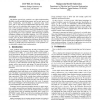Free Online Productivity Tools
i2Speak
i2Symbol
i2OCR
iTex2Img
iWeb2Print
iWeb2Shot
i2Type
iPdf2Split
iPdf2Merge
i2Bopomofo
i2Arabic
i2Style
i2Image
i2PDF
iLatex2Rtf
Sci2ools
ICCAD
2002
IEEE
2002
IEEE
ATPG-based logic synthesis: an overview
The ultimate goal of logic synthesis is to explore implementation flexibility toward meeting design targets, such as area, power, and delay. Traditionally, such flexibility is expressed using “don’t cares” and we seek the best implementation that does not violate them. However, the calculation and storing of don’t care information is CPU and memory-intensive. In this paper, we give an overview of logic synthesis approaches based on techniques developed for Automatic Test Pattern Generation (ATPG). Instead of calculating and storing don’t cares explicitly, ATPG-based logic synthesis techniques calculate the flexibility implicitly. Low CPU and memory usage make those techniques applicable for practical industrial circuits. Also, the basic ATPG-based logic level operations create predictable, small layout perturbations, making an ideal foundation for efficient physical synthesis. Theoretical results show that an efficient, yet simple add-a-wire-and-remove-a-wire operation cover...
| Added | 14 Jul 2010 |
| Updated | 14 Jul 2010 |
| Type | Conference |
| Year | 2002 |
| Where | ICCAD |
| Authors | Chih-Wei Jim Chang, Malgorzata Marek-Sadowska |
Comments (0)

